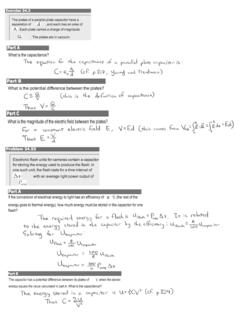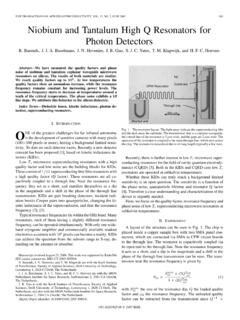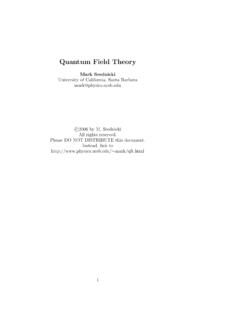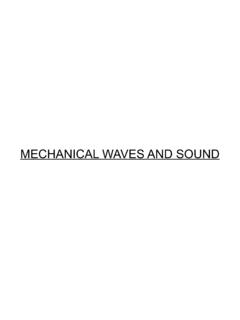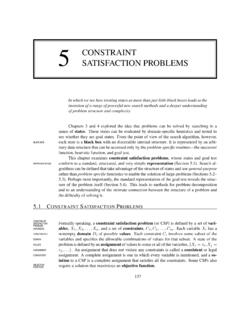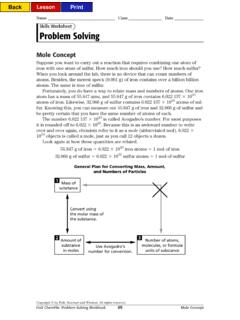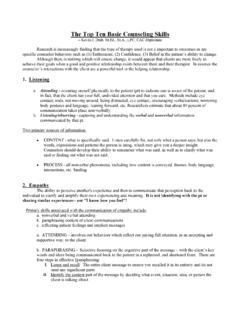Transcription of The Two-Body Problem
1 The Two-Body ProblemIn the previous lecture, we discussed a variety of conclusions we could makeabout the motion of an arbitrary collection of particles, subject only to a fewrestrictions. Today, we will consider a much simpler, very well-known problemin physics - an isolated system of two particles which interact through a centralpotential. This model is often referred to simply as thetwo- body the case of only two particles, our equations of motion reduce simply tom1 r1=F21;m2 r2=F12(1)A famous example of such a system is of course given by Newton s Law ofGravitation, where the two particles interact through a potential energy givenbyU12(|r1 r2|) =U21(|r2 r1|) =Gm1m2|r1 r2|2,(2)whereGis Newton s constant,G= 10 11N m2/kg2.(3)How can we go about finding the most general solution to this set of equations?
2 As with any physics Problem , the first thing we should do is make maximaluse of the symmetries or conservation laws of our Problem . First, becausethe two particles interact via a central potential, these two forces should obeyNewton s third law, as we discussed in the previous lecture. We know that as aresult, the total momentum of our system will be conserved, and so we shouldconsider the center of mass,R=m1r1+m2r2m1+m2=m1r1+m2r2M(4)the time derivative of which is given by the center of mass velocity,vCM=m1v1+m2v2M.(5)Now, in the previous lecture, we found that the acceleration of the center ofmass depended on the net external force,Fext=MaCM.(6)Since our system is isolated, the center of mass acceleration must be zero, andhence the center of mass velocity must be a constant,v(0)CM=m1v(0)1+m2v(0)2M.(7)Thus , the center of mass motion is given byR(t) =v(0)CMt.
3 (8)1 Since we already know the motion of the center of mass on general grounds,we can make use of this information to simplify our Problem . To see how, let sdefine the vector of relative distancer=r1 r2.(9)A simple algebraic rearrangement then yieldsr1=R+m2m1+m2r;r2=R m1m1+m2r.(10)From this expression, and the fact that we already knowR, our Problem simplyreduces to find the equation of motion satisfied byr, we return to our originalequations of motion and multiply the first bym2and the second bym1, inorder to findm1m2 r1=m2F21;m1m2 r2=m1F12.(11)If we then subtract the second equation from the first, we havem1m2( r1 r2) =m2F21 m1F12 m1m2(m2+m1) r=F21,(12)where we have made use of Newton s third law in the second equation. Be-cause the forces are derived from a central potential which only depends on thedistance between the two particles, we haveF21= r1U12(|r1 r2|) = 1U12(|r1 r2|)(13)Now, since the potential only depends onr, andnotthe center of massR,we can use the chain rule to write for thex-component of the derivative, forexample, r1xU12(|r|) = rx r1x rxU12(|r|) + Rx r1x RxU12(|r|) = rxU12(|r|),(14)and so on for the other coordinates.
4 Thus, I find that I can writem r= rU(|r|) F(r),(15)wherem =m1m2(m2+m1)(16)is thereduced massof the system. Thus, our Problem has effectively beenreduced to a one-particle system - mathematically, it is no different than a singleparticle with position vectorrand massm , subject to an external , conservation of momentum has dramatically simplified our of Angular MomentumSince our two particles interact with each other through a central potential, weknow that the total angular momentum of the system is conserved. However,since we have reduced our Problem to a one-particle system, it makes moresense to reformulate this statement in terms of the angular momentum of thisfictitious particle,L=m r v,(17)wherev= r.(18)Now, a short exercise in the chain rule shows us thatF(r) = rU(|r|) = rrdU(r)dr;r=|r|.(19)Therefore, the torque on the particle due toFis =r F r r= 0.
5 (20)That is, the torque vanishes because the force is parallel to the displacementvector. Thus, in the absence of any torque, the angular momentum of theparticle must be constant,ddtL= 0.(21)This fact is a general result for the motion of a particle in an external our one-particle system, conservation of angular momentum allows usto make a further simplification. For any three vectors, we can form thescalartriple product,a (b c) =b (c a) =c (a b).(22)The fact that all three of these expressions are equal is left as an exercise onyour homework. If we use this identity, we can see thatr L=m r (r v) =m v (r r) = 0.(23)Because this inner product is zero, it must be the case thatris alwaysperpen-dicularto the angular momentumL,r L(24)However, because the angular momentum is constant,there must be a fixedvector in space which the position vectorris always perpendicular to.
6 Giventhat the position vector is always perpendicular to a certain orientation in space,it must be the case that the position vectoralways lies in a a result of this fact, not only has our Problem been reduced to a one-particle system, it has also been effectively reduced to two dimensions. Because3our Problem is described by a radial force in two dimensions, at this point it ismost convenient to switch over to polar coordinates,rx=rcos ;ry=rsin .(25)We have chosen the convention that the plane which the particle travels in isthex-yplane, and that the angular momentum is oriented along thez-axis. Inthis set of coordinates, we can writed dt=l/m r2;l |L|,(26)which you ll show on your homework. This expression for the time derivativeof the angular coordinate makes another fact clear - the sign ofd /dtis alwayspositive, so that the particle always rotates around the center of our coordinatesystem in the same of EnergyThere is one last conservation law we of course have at our disposal, which isthe conservation of energy.
7 Since our particle s motion is described in terms ofa potential energy function, we know that the quantityE=12m v2+U(r)(27)should be conserved. Now, as we discussion in section this week, we rememberthat in polar coordinates, we can writev2= x2+ y2= r2+r2 2.(28)Therefore, our energy conservation constraint becomes, in polar coordinates,E=12m r2+12m r2 2+U(r).(29)However, we can eliminated /dtfrom this expression, using the result we foundabove. Substituting in this result, we findE=12m r2+12m r2(lm r2)2+U(r),(30)or,E=12m r2+12l2m r2+U(r) =12m r2+Ueff(r),(31)where we have defined theeffective potentialUeff(r) =12l2m r2+U(r).(32)4 Notice that aside from depending on the (constant) valuel, the effectivepotential is only a function ofr- there is no longer any dependence in theenergy conservation equation.
8 The expression above is mathematically identicalto a single particle in one dimension, with a coordinater, whose energy is thesum of its kinetic energy K=12m r2,(33)and also its potential energy, described by the effective potential. For this rea-son, we have now effectively reduced our Problem to aone-dimensional time evolution of our system is now determined by the two equationsE=12m r2+Ueff(r) ;d dt=l/m r2.(34)The first equation can be solved using the methods we have already been devel-oping in the course up until this point. Once we have done so, and determinedthe functional form ofr(t), we can find the angular coordinate by simply inte-grating (t) = 0+lm t0dt r2(t ).(35)The combination of linear momentum, angular momentum, and energy con-servation in our system has led to a dramatic simplification - a system of twoparticles in three-dimensional space has been reduced to a Problem of findingthe motion ofoneparticle travelling inonedimension.
9 Notice that while twoparticles moving in three dimensions involves 12 pieces of information (the posi-tion and velocity of both particles), our current simplified Problem only involvestwo - the position and velocity of a one-dimensional particle. Thus, we havetenfewer pieces of information to find. This dramatic simplification, along with theincredible ubiquity of the central potential, makes the Two-Body Problem one ofthe most well-known and most important problems in all of that in addition to being a nice mathematical trick, the reductionof our Problem to one particle moving in an external central potential is of-tenphysically motivatedas well. In many situations, especially in celestialmechanics, it is often the case that one of the two bodies is much, much moremassive than the other. If we assume this body ism2, then the reduced masssimply becomesm =m1m2(m2+m1) m1,(36)and the center of mass becomesR=m1r1+m2r2m1+m2 r2(37)Therefore, the difference vectorr=r1 r2 r1 R,(38)5simply defines the position of the smaller mass with respect to the position of thelarger mass, which is the center of mass itself.
10 Thus, to a good approximation,we can imagine that the lager mass is stationary (since the center of mass moveswith a constant velocity, which we can take to be zero), and that the smallermass is subject to an external potential due to this larger mass. So in thefollowing discussion when we consider the motion of such a system, you mayfind this intuitive picture to be helpful. This idea is shown in Figure 1: In the case that one of the two bodies is much more massive thanthe other, the location of the larger body effectively becomes the location of thecenter of mass, which we can take to be stationary. In this case, the smallermass is considered to be moving in an external potential due to the larger that a recurring theme of this course has been the subject of approx-imation methods, you may be wondering why we are so concerned with one ofthe few exactly solvable cases which appear in physics.

